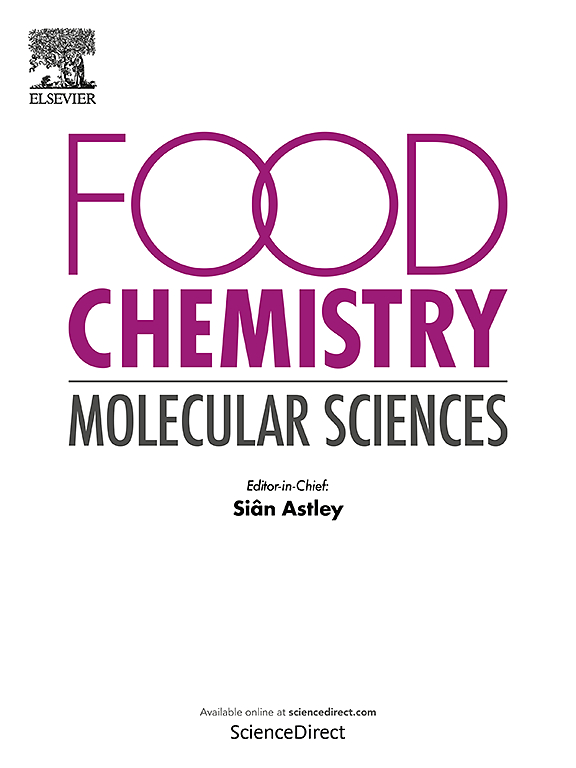Enhanced catalytic activity of a novel trypsin by semi-rational design with mechanistic insights from molecular simulations
IF 4.7
Q2 FOOD SCIENCE & TECHNOLOGY
引用次数: 0
Abstract
Trypsin is widely used in the food industry for meat processing, dairy production and seafood treatment. However, the industrial application of trypsin is constrained by the pathogenic risks associated with animal-derived trypsin and the low enzymatic activity of microbial-derived trypsin. This study aimed to enhance the catalytic activity of a novel trypsin heterologously expressed in Bacillus subtilis SCK6. Given the catalytic specificity of trypsin, numerous lysine and arginine residues within the trypsin are susceptible to autolytic cleavage, which may compromise the integrity and stability of its tertiary structure, thereby affecting its catalytic efficiency. To address this, a semi-rational design strategy was employed to introduce mutations at lysine and arginine residues. As a result, a trypsin variant with a 2.2-fold increase in enzymatic activity was obtained, reaching 93.9 U/ml. Further optimization of the fermentation process elevated the enzymatic activity to 132.8 U/ml. Additionally, this study pioneered molecular docking and molecular dynamics simulations in trypsin engineering, revealing that the introduced mutations stabilize the catalytic pocket and enhance enzyme activity. These findings demonstrate that structure-guided mutagenesis of autolysis-prone lysine and arginine residues can significantly improve the catalytic performance of microbial trypsin. This strategy provides a rational framework for the targeted engineering of trypsin variants and offers a practical approach for developing safer, high-activity preparations suitable for industrial food processing applications.
半理性设计增强一种新型胰蛋白酶的催化活性,并从分子模拟中获得机理见解
胰蛋白酶在食品工业中广泛应用于肉类加工、乳制品生产和海鲜处理。然而,胰蛋白酶的工业应用受到动物源性胰蛋白酶的致病风险和微生物源性胰蛋白酶的低酶活性的限制。本研究旨在提高一种在枯草芽孢杆菌SCK6中异源表达的新型胰蛋白酶的催化活性。鉴于胰蛋白酶的催化特异性,胰蛋白酶内部的大量赖氨酸和精氨酸残基容易发生自溶裂解,这可能会损害其三级结构的完整性和稳定性,从而影响其催化效率。为了解决这个问题,采用半理性设计策略在赖氨酸和精氨酸残基上引入突变。结果,获得了酶活性提高2.2倍的胰蛋白酶变体,达到93.9 U/ml。进一步优化发酵工艺,酶活达到132.8 U/ml。此外,本研究开创了胰蛋白酶工程的分子对接和分子动力学模拟,揭示了引入的突变稳定了催化袋并增强了酶的活性。这些发现表明,结构导向诱变易自溶赖氨酸和精氨酸残基可以显著提高微生物胰蛋白酶的催化性能。该策略为胰蛋白酶变异的靶向工程提供了合理的框架,并为开发适合工业食品加工应用的更安全、高活性的制剂提供了实用的方法。
本文章由计算机程序翻译,如有差异,请以英文原文为准。
求助全文
约1分钟内获得全文
求助全文
来源期刊

Food Chemistry Molecular Sciences
Agricultural and Biological Sciences-Food Science
CiteScore
6.00
自引率
0.00%
发文量
83
审稿时长
82 days
期刊介绍:
Food Chemistry: Molecular Sciences is one of three companion journals to the highly respected Food Chemistry.
Food Chemistry: Molecular Sciences is an open access journal publishing research advancing the theory and practice of molecular sciences of foods.
The types of articles considered are original research articles, analytical methods, comprehensive reviews and commentaries.
Topics include:
Molecular sciences relating to major and minor components of food (nutrients and bioactives) and their physiological, sensory, flavour, and microbiological aspects; data must be sufficient to demonstrate relevance to foods and as consumed by humans
Changes in molecular composition or structure in foods occurring or induced during growth, distribution and processing (industrial or domestic) or as a result of human metabolism
Quality, safety, authenticity and traceability of foods and packaging materials
Valorisation of food waste arising from processing and exploitation of by-products
Molecular sciences of additives, contaminants including agro-chemicals, together with their metabolism, food fate and benefit: risk to human health
Novel analytical and computational (bioinformatics) methods related to foods as consumed, nutrients and bioactives, sensory, metabolic fate, and origins of foods. Articles must be concerned with new or novel methods or novel uses and must be applied to real-world samples to demonstrate robustness. Those dealing with significant improvements to existing methods or foods and commodities from different regions, and re-use of existing data will be considered, provided authors can establish sufficient originality.
 求助内容:
求助内容: 应助结果提醒方式:
应助结果提醒方式:


